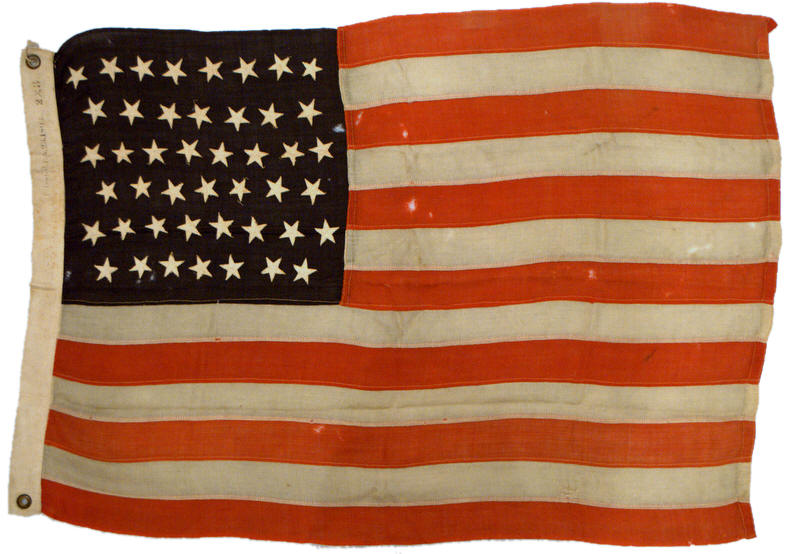|
 One of the most
intriguing stories in American Flag lore is that of
Henry Bowman. The date of 1892 is significant with
regards to zig-zag stitching and American flags in that
on February 23, 1892, Mr. Henry A. Bowman, an African
American, was awarded patent #469,395, Device for Making
Flags, in which he patented the use of zig-zag stitching
specifically for sewing stars onto American flags.
Henry’s flag company began producing flags and marking
the hoist of the flag with the date and patent number.
Unfortunately, he was unable to protect his patent, and
others also made flags using this technique. On March
26, 1894, Bowman brought the case of Bowman v. De Grauw,
et. al. to the Circuit Court of New York. He lost the
case, with the judge ruling that the technique was not
sufficiently novel to warrant a patent, and soon the
Bowman company went out of business. (You can
read the ruling of the case here, in the Federal
Reporter, vol. 60, pp. 907-912.) The flag above is a very
scarce example made by Henry Bowman's flag company.
The signature sign that this is a
Bowman flag is the stenciled patent marking on the
hoist, which reads "Patented Feb. 23, 1892." The
flag is very small, marked "2x3" on the hoist to
represent 2 feet x 3 feet in size. The stars on
the flag, zig-zag stitched using Bowman's patented
stitching method, are small and scattered on their axis.
This flag is one of the smallest I've seen in this
period that features the full complement of stars.
Each star is hand cut and they vary in size, some being
noticeably smaller than their neighbors, resulting in a
charming and folky presentation of the 45 star flag. One of the most
intriguing stories in American Flag lore is that of
Henry Bowman. The date of 1892 is significant with
regards to zig-zag stitching and American flags in that
on February 23, 1892, Mr. Henry A. Bowman, an African
American, was awarded patent #469,395, Device for Making
Flags, in which he patented the use of zig-zag stitching
specifically for sewing stars onto American flags.
Henry’s flag company began producing flags and marking
the hoist of the flag with the date and patent number.
Unfortunately, he was unable to protect his patent, and
others also made flags using this technique. On March
26, 1894, Bowman brought the case of Bowman v. De Grauw,
et. al. to the Circuit Court of New York. He lost the
case, with the judge ruling that the technique was not
sufficiently novel to warrant a patent, and soon the
Bowman company went out of business. (You can
read the ruling of the case here, in the Federal
Reporter, vol. 60, pp. 907-912.) The flag above is a very
scarce example made by Henry Bowman's flag company.
The signature sign that this is a
Bowman flag is the stenciled patent marking on the
hoist, which reads "Patented Feb. 23, 1892." The
flag is very small, marked "2x3" on the hoist to
represent 2 feet x 3 feet in size. The stars on
the flag, zig-zag stitched using Bowman's patented
stitching method, are small and scattered on their axis.
This flag is one of the smallest I've seen in this
period that features the full complement of stars.
Each star is hand cut and they vary in size, some being
noticeably smaller than their neighbors, resulting in a
charming and folky presentation of the 45 star flag.

The signature patent marking on the
hoist of a Henry A. Bowman Flag
|

